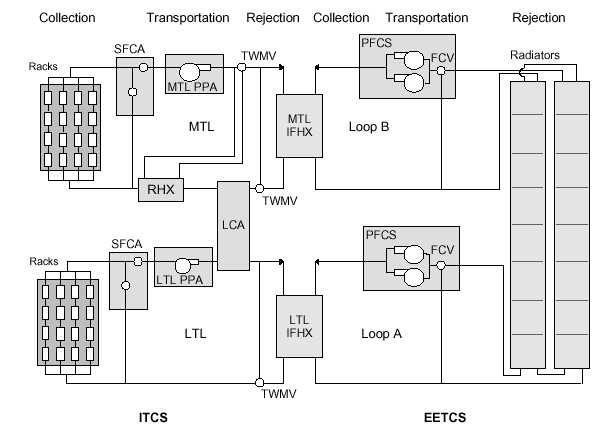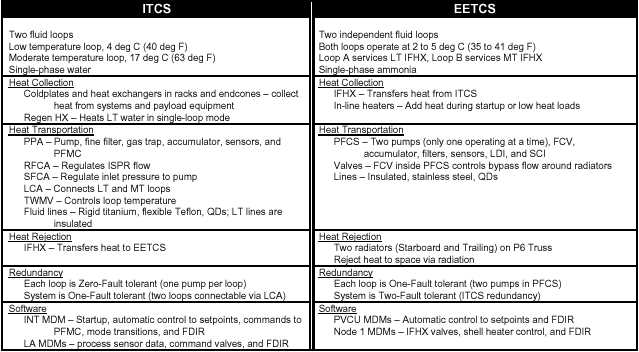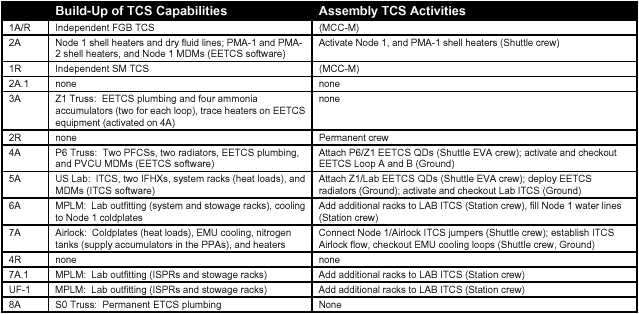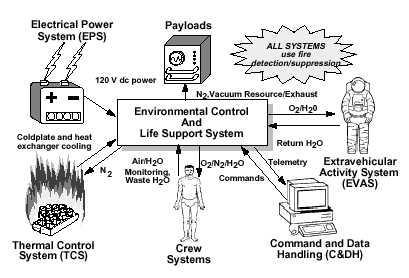Technical Summary Sheets





D.1 ENVIRONMENTAL CONTROL AND LIFE SUPPORT SYSTEM OVERVIEW






D.1 ENVIRONMENTAL CONTROL AND LIFE SUPPORT SYSTEM OVERVIEW

D.2 Key Design Concept: U.S. ECLSS based on distributed systems, Russian ECLSS based on modular systems.
Interfaces:

Typical Activities:
Crew
- Equalize pressure between volumes, such as Node 1 and vestibule
- Add gas to atmosphere from Progress gas panel
- Connect Intermodule Ventilation ducting between modules
- Connect payload racks to Lab Nitrogen System and Vacuum System
- Adjust the air temperature within a module
Controller
- Monitor total and partial pressures of various modules
- Activate and check-out various assemblies, such as Major Constituent Analyzer, Common Cabin Assembly, or Pressure Control Assembly
Key Operational Constraints:
- At 8A, Russian equipment is prime for atmospheric O2/N2 make-up
- EVAs must be performed out of the Russian segment until arrival of the Airlock (7A)
- Russian equipment is prime for water supply until arrival of US Habitation Module (16A)
D.3 Technical Summary Sheet
D.3.1 Payloads
The types
of research planned for ISS are summarized below:
·
Life Sciences: Study how plants and animals adjust to the absence of gravity.
Conduct research which could aid in the treatments and prevention of numerous
diseases and medical conditions experienced on Earth.
· Microgravity Sciences: Study processes which are obscured by gravity on Earth and test physical theories at levels of accuracy that are impossible on Earth. Specific disciplines of microgravity science which will be studied aboard ISS include: materials science, combustion science, fluid physics, fundamental physics, and biotechnology.
· Space Sciences: Seek to solve the mysteries of the universe, explore the solar system, find planets around other stars, and search for life beyond Earth. The focus of space science includes studies on solar physics, cosmic physics, astronomy, and astrophysics.
· Earth Sciences: Study the Earth’s system and the environmental response to natural and human-induced variations in atmospheric quality, regional and global climate, geologic activity, land use and food production, and ocean and fresh water health.
· Commercial Product Development: Increase private sector interest and involvement in commercial space-related activities and stimulate advances in promising areas of space research and development with commercial applications.
· Engineering Research and Technology: Provide the opportunity for academic institutions and industry to create “test-beds” and run experiments associated with the advancement of technology and engineering research. Some of the specific areas that will be investigated are: advanced energy storage systems, advanced robotics capabilities, communication systems, electromagnetic propulsion and advanced sensors. The following payload components are provided to support research operations on ISS
· U.S. Laboratory Module: NASA contribution to the ISS laboratory complement that accommodates 13 payload racks.
· International Standard Payload Rack (ISPR): Provides the basic housing and support structure for the mounting of payload hardware and equipment that are to be installed in the U.S. Lab and IP modules.
· Facility Class Payloads: A long term or permanent Station resident that provides services and accommodations for experiments in a particular science discipline.
· EXpedite the PRocessing of Experiments to Space Station (EXPRESS): Provides payload accommodations which allow quick, simple integration by using standardized hardware interfaces and a streamlined integration approach.
·· Laboratory Support Equipment (LSE): Devices that are shared on a noninterference basis by multiple research users.
·· Attached Payloads: Payloads located outside of the pressurized volume of the Space Station on the truss or the Japanese Experiment Module Exposed Facility (JEM EF).
·· Centrifuge Accommodation Module (CAM): Laboratory module built by NASDA under NASA contract that accommodates a variable speed centrifuge and plant and animal habitats.
·· Japanese Experiment Module (JEM): NASDA contribution to the ISS laboratory complement that accommodates 10 payload racks and 10 attached payload sites.
·· Columbus Orbital Facility (COF): ESA contribution to the ISS laboratory complement that accommodates 10 payload racks.
·· Russian Research Modules: RSA contribution to the ISS laboratory complement which is currently in the conceptual design phase. The U.S. Laboratory Facility Class Payloads are as follows:
· Human Research Facility: HRF is a two-rack designed to support life sciences investigations using human subjects.
· Advanced Human Support Technology: Advanced Human Support Technology (AHST) Payloads use a single modified EXPRESS Rack. AHST payloads are divided in three major categories: Space Human Factors Engineering (SHFE), Advanced Life Support, and Advanced Environmental Monitoring and Control Payloads.
· Space Station Biological Research Project: SSBRP focuses on payloads designed to study the role of gravity in the evolution, development, and functions of biological processes involving cells, plants, and animals.
·· Materials Science Research Facility: MSRF helps to conduct investigations that deal with the properties of matter and how they relate to each other.
· Microgravity Science Glovebox: MSG is a multiuser facility that enables users to conduct small science and technology investigations in fluid physics, combustion science, materials science, biotechnology, and space processing.
· Fluids and Combustion Facility: FCF payloads use low gravity to study the properties and behavior of fluids (liquids, gases and mixtures), and fundamental combustion phenomena.
· Biotechnology Facility: BTF supports a variety of payloads that focus on cell cultures, tissue engineering, protein crystal growth, biochemical separations, and micro-carrier and micro-capsule preparation.
· Window Observational Research Facility: WORF provides a crew workstation at the U.S. Laboratory window to support research-quality optical Earth observations.
· X-ray
Crystallography Facility: XCF is composed of two racks designed to support
crystal growth, harvesting, mounting, and x-ray diffraction data collection.